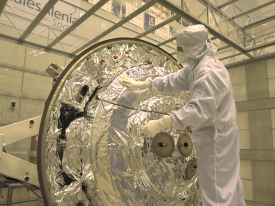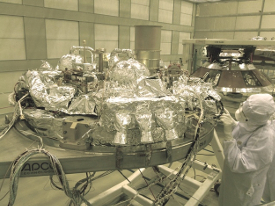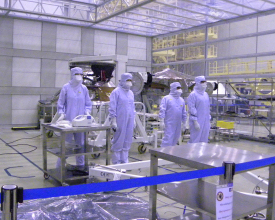Planetary protection
 |
| Taking microbiological samples from Schiaparelli, inside the portable cleanroom tent, at Baikonur. Credit: ESA |
Meeting these planetary protection constraints is not just an aspiration; it is a legal obligation. The Committee on Space Research (COSPAR) has formulated a planetary protection policy to guide compliance with the United Nations Outer Space Treaty.
ESA has adopted this policy and acts on behalf of its Member States to ensure that the requirements are met for all missions the Agency is flying or contributing to.
In practice, for some missions planetary protection sets limits for the level of acceptable microbiological contamination and for the probability of a spacecraft crashing on specific target bodies.
Mars is a primary target in the search for evidence of extraterrestrial life, past or present, and for this reason stringent planetary protection requirements apply.
 |
| Taking microbiological samples from Schiaparelli, inside the portable cleanroom tent, at Baikonur. Credit: ESA |
To satisfy these requirements, for orbiters or for spacecraft performing flybys, a space agency must demonstrate one of two things. Either that there is a very small chance of the spacecraft crashing or impacting on its target world or that, in the event of a crash, the chance of biologically contaminating the planet is below a set limit.
For the ExoMars Trace Gas Orbiter, ESA have chosen to satisfy the impact probability constraint. The Agency has demonstrated that there is a less than 1 in 100 chance of an impact on the planet for the first 20 years after launch and less than 1 in 20 chance for the time period from 20 to 50 years after launch.
These assessments are made by evaluating the operational reliability of the mission, the flight hardware reliability, and the effects of the natural space environment such as micrometeoroids or Mars atmospheric variations. The launcher upper stage has also been included in these assessments to ensure that it does not impact Mars after separating from the spacecraft.
 |
| Assembling Schiaparelli in the microbiological controlled cleanroom in Turin, Italy. Credit: ESA |
For a lander or rover the limits on the level of possible microbiological contamination are much more stringent. For Schiaparelli – the ExoMars 2016 entry, descent, and landing demonstrator module – the ExoMars project built a new cleanroom, in which the microbiological contamination could be strictly controlled during the assembly of the module at Thales Alenia Space in Italy.
When the module was assembled, it was transferred to the Thales Alenia Space premises at Cannes, France, for testing. A portable ‘clean tent’ that could be used during these activities was set up in Cannes and later, when Schiaparelli was transferred to the launch site in Baikonur, the clean tent was transferred there too. In addition, the project has built two new microbiological laboratories to measure the microbiological contamination levels in the cleanrooms and on the flight system: one at Thales Alenia Space in Italy, and one at the launch site in Baikonur, Kazakhstan.
 |
|
The TAS-I planetary protection team, inside the cleanroom tent at Baikonur. Credit: Thales Alenia Space |
A dedicated training programme for all personnel who were involved in the construction and testing of the module, and the development of new cleanroom operating procedures were implemented.
All flight hardware, including the launcher upper stage and the launcher fairing, had to go through numerous cleaning cycles. Sterile 80% isopropyl alcohol was used for this. The cleanrooms are cleaned with more aggressive chemicals, including hydrogen peroxide solutions.
Most of the Schiaparelli hardware was exposed to dry heat treatment – exposing it to temperatures between 110°C to 125°C for several hours to several days – to reduce the microbiological contamination. Almost 3000 microbiological tests were carried out throughout the assembly, test and launch operations to check that these procedures were working well.
The planetary protection requirements have been verified by internal and independent assessments throughout the project lifecycle during reviews, audits and tests. The final certificate of compliance has been issued for the launch readiness review.
As a result of these special measures and the excellent work of the Thales Alenia Space planetary protection, laboratory, and assembly, integration and test teams, the Agency has demonstrated that ExoMars 2016 is well within the constraints specified for the microbiological contamination and the probability of impact on Mars.




